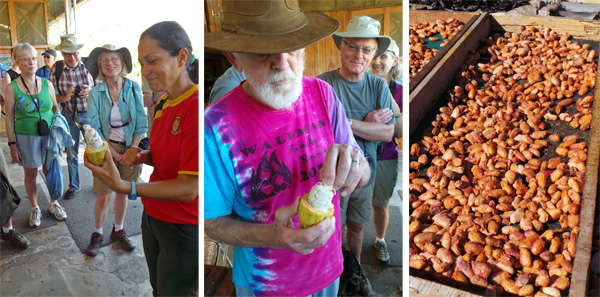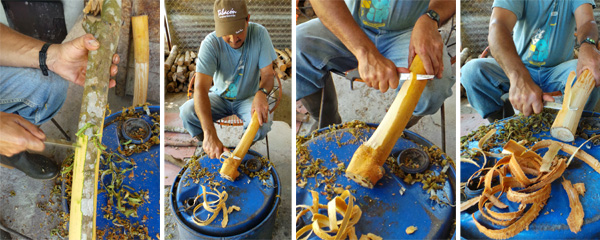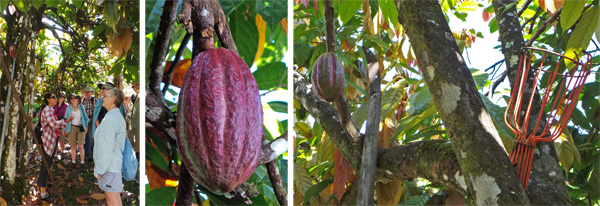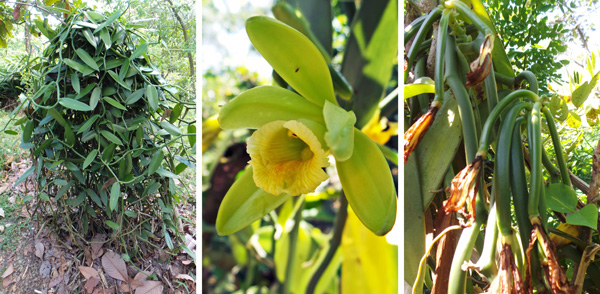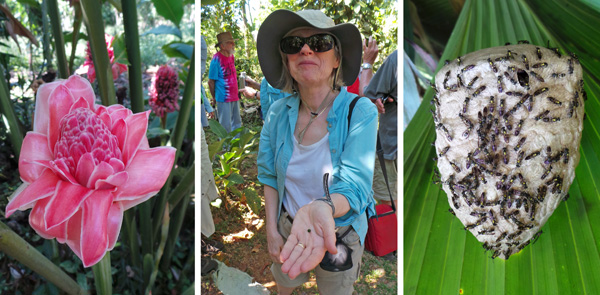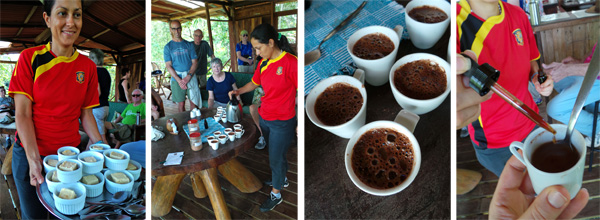This morning we visited Villa Vanilla, a small artisanal producer of vanilla and other spices. We were greeted by Giselle, who invited us over to see vanilla beans and some other spices drying on elevated racks in the hot sun. The mature beans are dried for a specific length of time before they are stored and then aged a year before sale. There were also some cacao seeds, both fresh and roasted, cardamom pods, black pepper and turmeric root drying in trays in the sun.
Villa Vanilla (L); vanilla beans drying on racks in the sun (C); trays of black pepper, turmeric and cacao beans drying in the sun (R).
Inside the open-air building, out of the hot sun, Giselle gave a more lengthy introduction to vanilla production. There are about 60 species in the genus Vanilla, a group of tropical orchids native to Central and South America. V. planifolia is an epiphytic type cultivated for the seed pods. She showed us the “beans” (really the dried, processed seed pods), and told about how they are prepared to be used as a flavoring. She passed around a split bean so we could see the very tiny seeds that are provide the flavor. She then explained how extracts are made, using vodka or rum in their artisanal operation, but any type of alcohol can be used.
Tour guide explaining where vanilla comes from (L); the cured beans and extracts (LC); a seed pod opened to release the tiny black seeds (RC); Jeff smells a bottle of vanilla extract (R).
Then we shifted sour focus to chocolate, with Giselle telling about cacao pods and opening one to show the white-covered seeds inside. The pod was passed around so that each person could taste the mildly sweet, slippery covering around each seed. The seed is dried, roasted and processed to create chocolate.
The group watches as the cacao pod is opened (L); John samples one of the cacao seeds covered with white (C); roasted cacao seeds (R).
Next we learned about the other spices grown on the property, including cardamom, turmeric, cinnamon, black pepper, chiles and allspice. Containers of whole and/or ground spices were passed around for the group to smell the distinctive aroma of each as she explained what plant part they are and how they are used. For example, black pepper is just the green fruits that have been dried, while white pepper is the same plant part, but more mature and processed by water fermentation to remove the outer part before being dried.
Learning about spices (L), such as black and white peppercorns (C) and turmeric, with a piece of fresh tuber, dried tuber and ground tuber on a stone metate (R).
We watched a man scraping the thin green and white mottled bark off 2 foot lengths of cinnamon branches, and then peeling off thin, curling strips of the inner bark with his knife. We were invited to taste the fresh, spicy inner bark, which packed quite a punch.
Removing the thin bark on a branch of cinnamon (Cinnamomum zeylanicum) (L), and peeling off strips of the inner bark (LC, RC, and R).
We went outside and stood under one of the large cacao trees where Giselle discussed how the pods are harvested and other aspects of the trees and production on their land. Fat reddish pods hung down from the thick branches in places, with smaller ones coming behind. Cacao is in production year-round, while the vanilla blooms more seasonally.
Standing under a cacao tree learning how the trees are grown (L); a cacao pod (C); long-handled saw and basket for harvesting cacao pods high in the trees (R).
From there we walked out into the plantation, where the vanilla and other crops are grown biodynamically, using compost and without any synthetic pesticides. The vanilla vines are put onto 4-5 foot tall tree trunks (the tops of the trees are cut off and usually don’t regrow) and allowed to grow up until workers position the vines downward so they will grow up again, looping over and over again to create a dense mass of the sparsely spaced, leathery leaves. The greenish-yellow flowers open at night and only bloom for a day, so by the time we got out to see one of the flowers it was already starting to close up. Workers had come through earlier that morning to pollinate the flowers by hand to assure seed set. It takes up to a year for the seed pods to elongate to the mature size. They looked somewhat like a clump of green beans hanging from the spot where the cluster of flowers had been a long time before.
We continued along the path past beautiful heliconias and ginger plants in bloom, cinnamon trees, a pepper vine (where we got to taste green pepper berries), some native orchids and lots more plants. Butterflies flitted all around us, and we spotted a couple of small wasp nests of different kinds, while cicadas created a nearly deafening buzz in the trees overhead. A few patches of clouds drifted over, mercifully lowering the temperature in their shade considerably.
Torch ginger (Etlingera elatior) (L); Sherry offers a green pepper fruit (C); a wasp nest on the underside of a leaf (R).
We continued on to the two story open-air structure at Punta Mira, and hiked up the stairs to enjoy the dramatic view over the countryside and settle into the chairs for some tasting. First Giselle served little glasses of chilled cinnamon tea, made from their own dried bark that had been steeped in water for a very refreshing beverage – that would be equally good hot in the winter back home.
View from the second story of the structure at Punta Mira (L); Judy takes a glass of cinnamon tea (C); and the colorful cinnamon tea (R).
Next we were given a small piece of very cold vanilla cheesecake, obviously made with their own vanilla. Then we were served a tiny scoop of really creamy vanilla ice cream set on a small chocolate cookie (made from their own cacao). The final sample was hot chocolate, made from either plain cocoa or Mexican-style with just a hint of chile. Giselle spooned the powdered chocolate into cups, added hot water, and invited us to taste the thin concoction. After trying it plain, she came around to each person and added a few drops of vanilla extract so we could taste the difference. As a final treat, she passed out cookies make with their cacao nibs, as we finished sipping the hot chocolate.
Vanilla cheesecake is served (L); pouring water (LC) for hot chocolate (RC); adding vanilla to the hot chocolate (R).
Then it was time to troop over to the Spice Shoppe, where we could purchase packaged spices, small bottles of vanilla extract, or whole vanilla beans to take home.



